2015 VOLKSWAGEN POLO wheel
[x] Cancel search: wheelPage 36 of 100
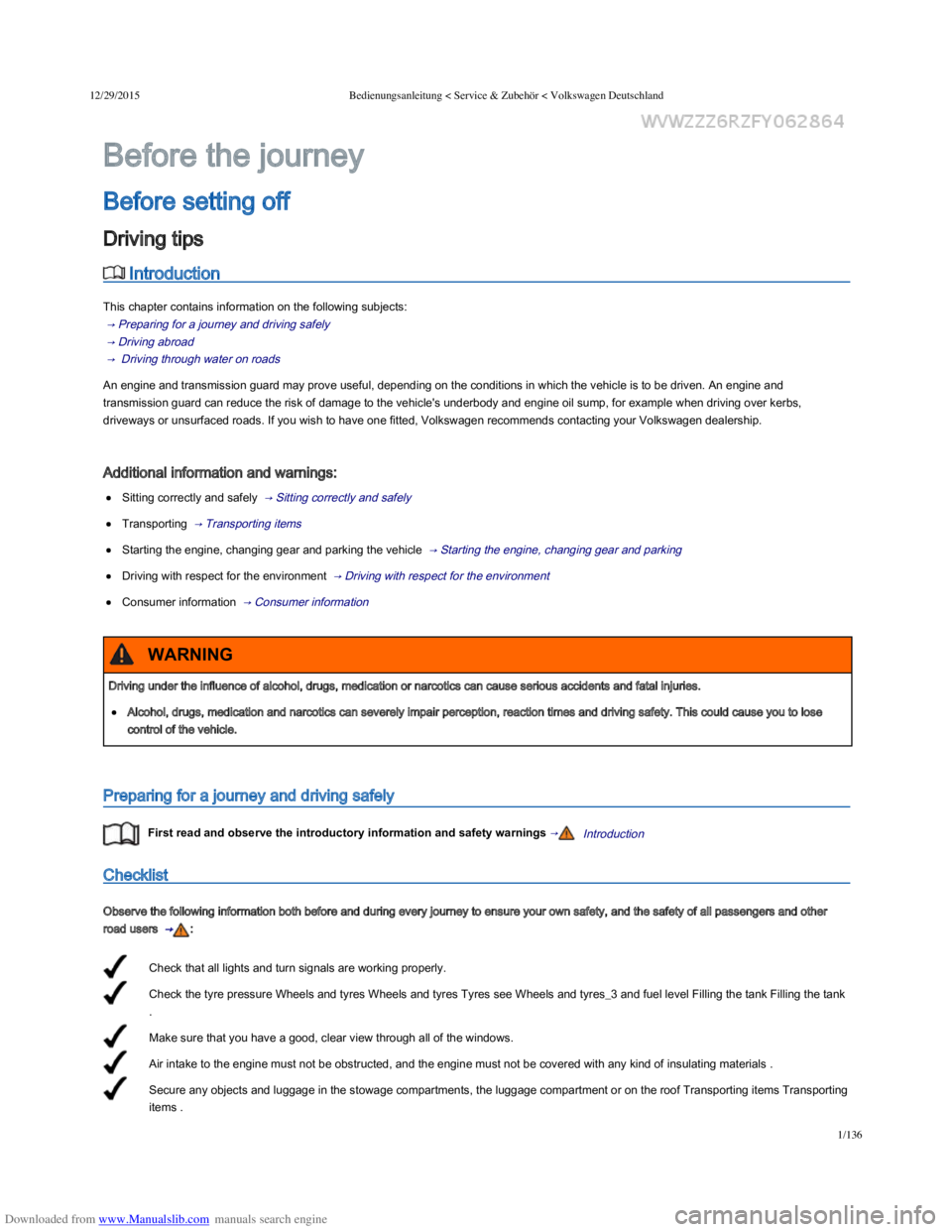
Downloaded from www.Manualslib.com manuals search engine 12/29/2015Bedienungsanleitung < Service & Zubehör < Volkswagen Deutschland
1/136
Check that all lights and turn signals are working properly.
Check the tyre pressure Wheels and tyres Wheels and tyres Tyres see Wheels and tyres_3 and fuel level Filling the tank Filling the tank
.
Make sure that you have a good, clear view through all of the windows.
Air intake to the engine must not be obstructed, and the engine must not be covered with any kind of insulating materials .
Secure any objects and luggage in the stowage compartments, the luggage compartment or on the roof Transporting items Transporting
items .
Introduction
This chapter contains information on the following subjects:
→ Preparing for a journey and driving safely
→ Driving abroad
→ Driving through water on roads
An engine and transmission guard may prove useful, depending on the conditions in which the vehicle is to be driven. An engine and
transmission guard can reduce the risk of damage to the vehicle's underbody and engine oil sump, for example when driving over kerbs,
driveways or unsurfaced roads. If you wish to have one fitted, Volkswagen recommends contacting your Volkswagen dealership.
Additional information and warnings:
Sitting correctly and safely → Sitting correctly and safely
Transporting → Transporting items
Starting the engine, changing gear and parking the vehicle → Starting the engine, changing gear and parking
Driving with respect for the environment → Driving with respect for the environment
Consumer information → Consumer information
Preparing for a journey and driving safely
First read and observe the introductory information and safety warnings →Introduction
Checklist
Observe the following information both before and during every journey to ensure your own safety, and the safety of all passengers and other
road users → :
Before the journey
Before setting off
Driving tips
Driving under the influence of alcohol, drugs, medication or narcotics can cause serious accidents and fatal injuries.
Alcohol, drugs, medication and narcotics can severely impair perception, reaction times and driving safety. This could cause you to lose
control of the vehicle.
WARNING
Page 39 of 100
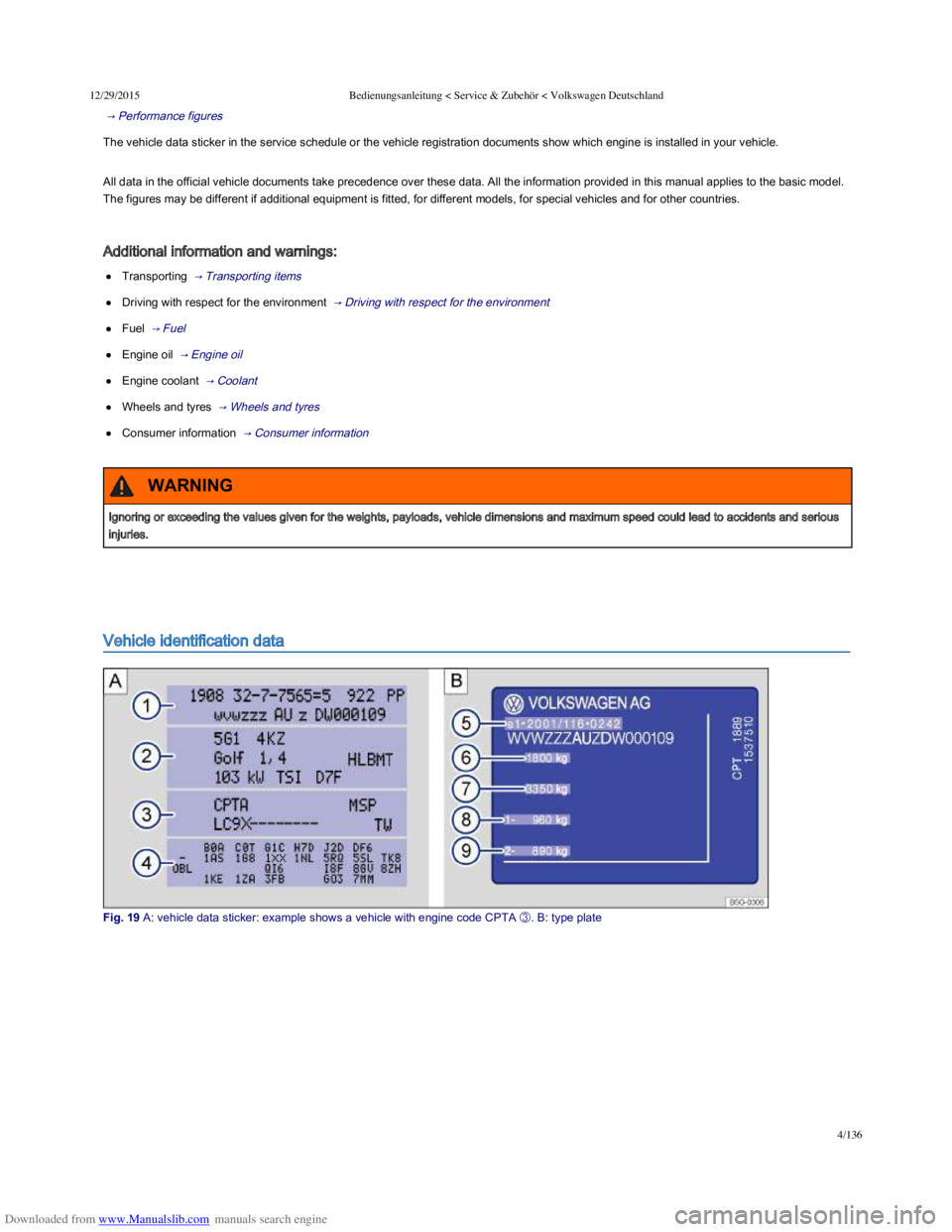
Downloaded from www.Manualslib.com manuals search engine 12/29/2015Bedienungsanleitung < Service & Zubehör < Volkswagen Deutschland
4/136
→ Performance figures
The vehicle data sticker in the service schedule or the vehicle registration documents show which engine is installed in your vehicle.
All data in the official vehicle documents take precedence over these data. All the information provided in this manual applies to the basic model.
The figures may be different if additional equipment is fitted, for different models, for special vehicles and for other countries.
Additional information and warnings:
Transporting → Transporting items
Driving with respect for the environment → Driving with respect for the environment
Fuel → Fuel
Engine oil → Engine oil
Engine coolant → Coolant
Wheels and tyres → Wheels and tyres
Consumer information → Consumer information
Vehicle identification data
Fig. 19 A: vehicle data sticker: example shows a vehicle with engine code CPTA
Page 40 of 100
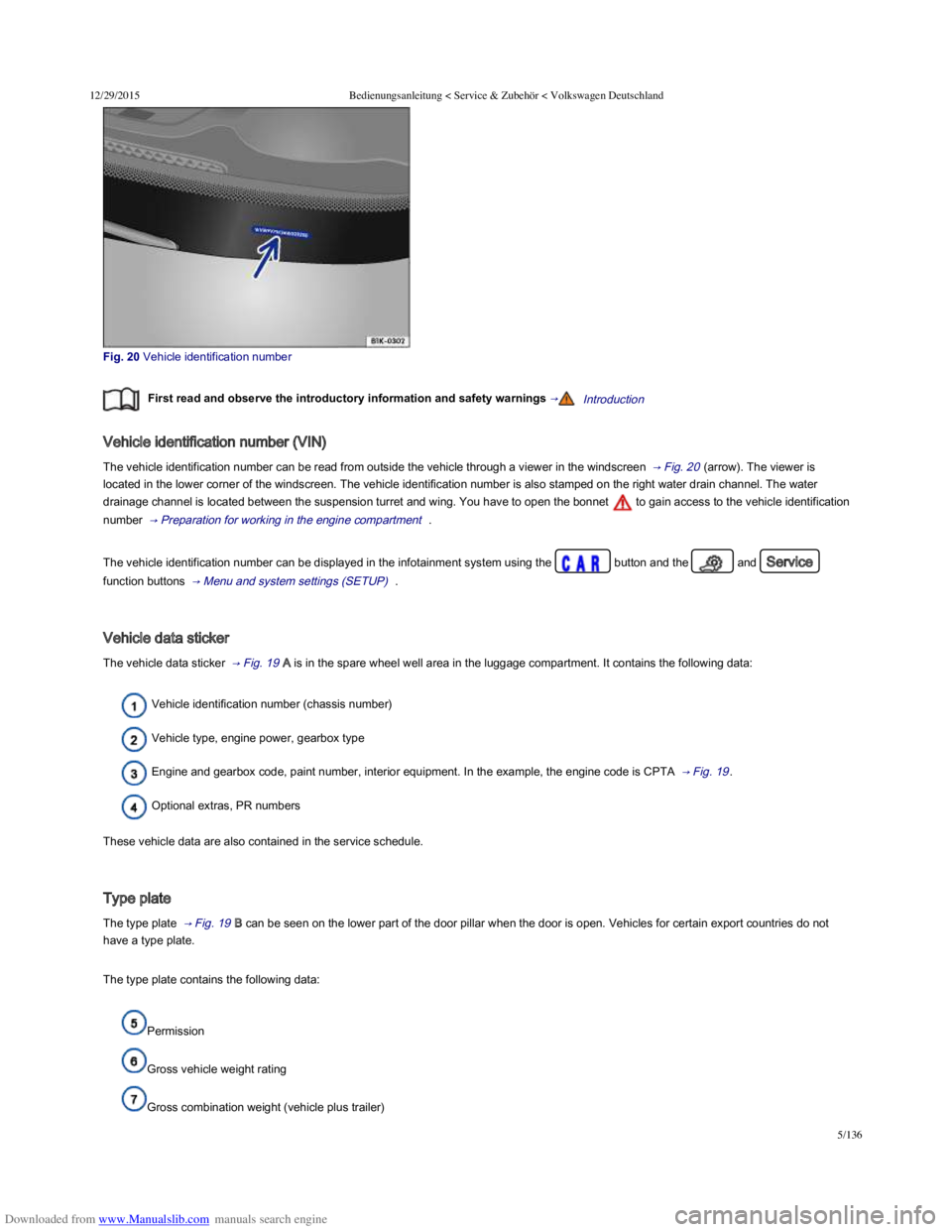
Downloaded from www.Manualslib.com manuals search engine 12/29/2015Bedienungsanleitung < Service & Zubehör < Volkswagen Deutschland
5/136
Fig. 20 Vehicle identification number
First read and observe the introductory information and safety warnings →Introduction
Vehicle identification number (VIN)
The vehicle identification number can be read from outside the vehicle through a viewer in the windscreen → Fig. 20 (arrow). The viewer is
located in the lower corner of the windscreen. The vehicle identification number is also stamped on the right water drain channel. The water
drainage channel is located between the suspension turret and wing. You have to open the bonnet to gain access to the vehicle identification
number → Preparation for working in the engine compartment .
The vehicle identification number can be displayed in the infotainment system using the button and the and Service
function buttons → Menu and system settings (SETUP) .
Vehicle data sticker
The vehicle data sticker → Fig. 19 A is in the spare wheel well area in the luggage compartment. It contains the following data:
Vehicle identification number (chassis number)
Vehicle type, engine power, gearbox type
Engine and gearbox code, paint number, interior equipment. In the example, the engine code is CPTA → Fig. 19 .
Optional extras, PR numbers
These vehicle data are also contained in the service schedule.
Type plate
The type plate → Fig. 19 B can be seen on the lower part of the door pillar when the door is open. Vehicles for certain export countries do not
have a type plate.
The type plate contains the following data:
Permission
Gross vehicle weight rating
Gross combination weight (vehicle plus trailer)
Page 42 of 100
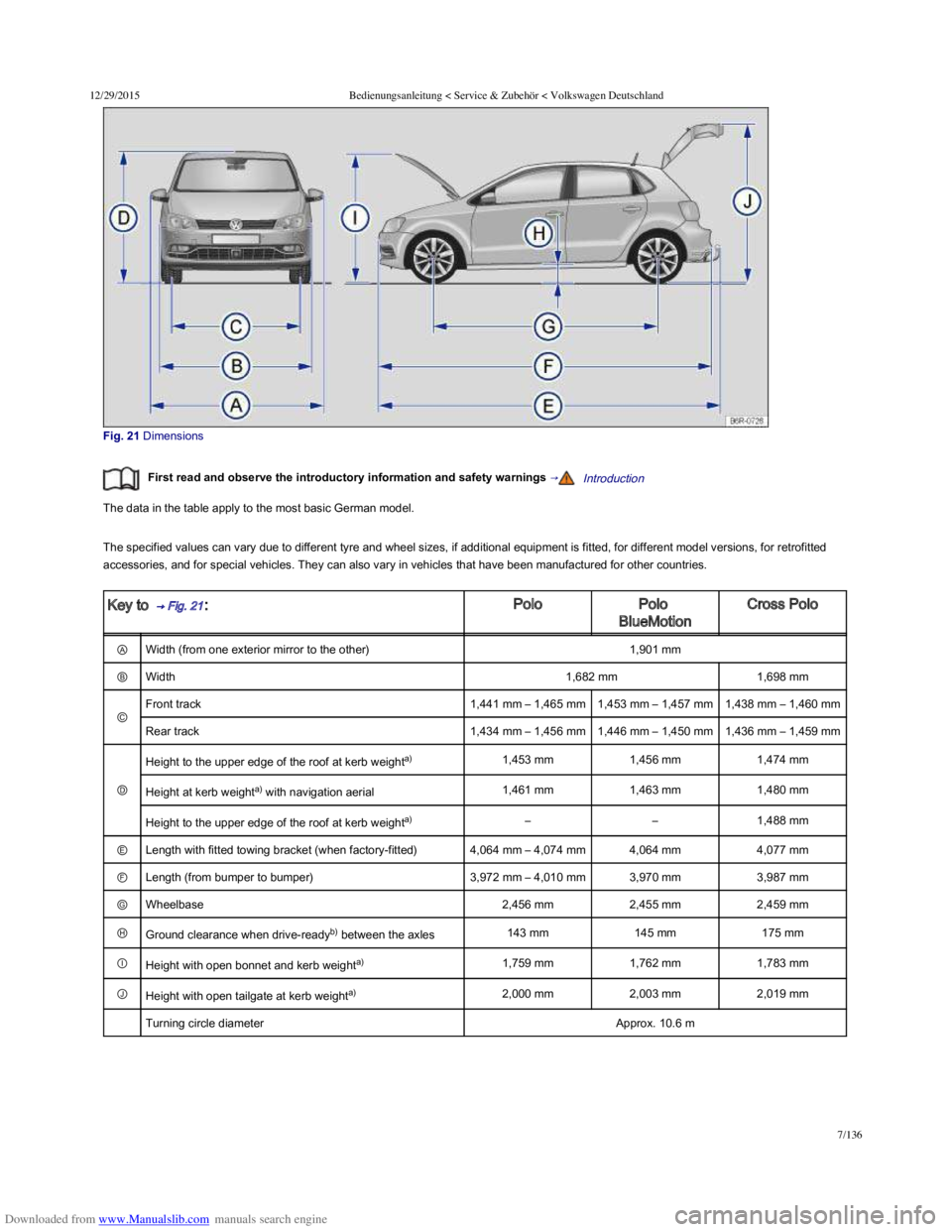
Downloaded from www.Manualslib.com manuals search engine 12/29/2015Bedienungsanleitung < Service & Zubehör < Volkswagen Deutschland
7/136
Fig. 21 Dimensions
First read and observe the introductory information and safety warnings →Introduction
The data in the table apply to the most basic German model.
The specified values can vary due to different tyre and wheel sizes, if additional equipment is fitted, for different model versions, for retrofitted
accessories, and for special vehicles. They can also vary in vehicles that have been manufactured for other countries.
Key to → Fig. 21 :PoloPolo
BlueMotion
Cross Polo
ⒶWidth (from one exterior mirror to the other)1,901 mm
ⒷWidth1,682 mm1,698 mm
Ⓒ
Front track1,441 mm – 1,465 mm1,453 mm – 1,457 mm1,438 mm – 1,460 mm
Rear track1,434 mm – 1,456 mm1,446 mm – 1,450 mm1,436 mm – 1,459 mm
Ⓓ
Height to the upper edge of the roof at kerb weighta)1,453 mm1,456 mm1,474 mm
Height at kerb weighta) with navigation aerial1,461 mm1,463 mm1,480 mm
Height to the upper edge of the roof at kerb weighta)––1,488 mm
ⒺLength with fitted towing bracket (when factory-fitted)4,064 mm – 4,074 mm4,064 mm4,077 mm
ⒻLength (from bumper to bumper)3,972 mm – 4,010 mm3,970 mm3,987 mm
ⒼWheelbase2,456 mm2,455 mm2,459 mm
ⒽGround clearance when drive-readyb) between the axles143 mm145 mm175 mm
ⒾHeight with open bonnet and kerb weighta)1,759 mm1,762 mm1,783 mm
ⒿHeight with open tailgate at kerb weighta)2,000 mm2,003 mm2,019 mm
Turning circle diameterApprox. 10.6 m
Page 68 of 100
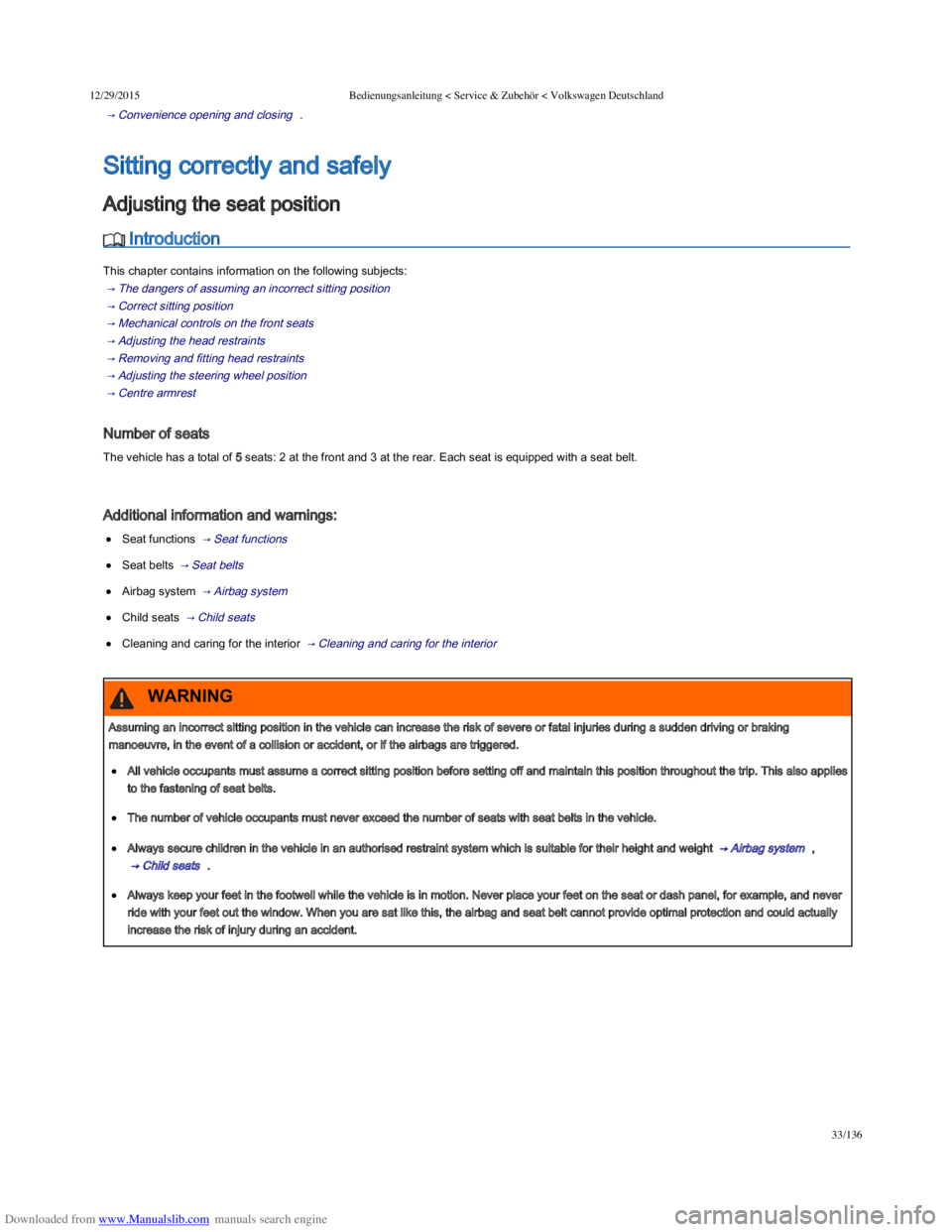
Downloaded from www.Manualslib.com manuals search engine 12/29/2015Bedienungsanleitung < Service & Zubehör < Volkswagen Deutschland
33/136
→ Convenience opening and closing .
Introduction
This chapter contains information on the following subjects:
→ The dangers of assuming an incorrect sitting position
→ Correct sitting position
→ Mechanical controls on the front seats
→ Adjusting the head restraints
→ Removing and fitting head restraints
→ Adjusting the steering wheel position
→ Centre armrest
Number of seats
The vehicle has a total of 5 seats: 2 at the front and 3 at the rear. Each seat is equipped with a seat belt.
Additional information and warnings:
Seat functions → Seat functions
Seat belts → Seat belts
Airbag system → Airbag system
Child seats → Child seats
Cleaning and caring for the interior → Cleaning and caring for the interior
Sitting correctly and safely
Adjusting the seat position
Assuming an incorrect sitting position in the vehicle can increase the risk of severe or fatal injuries during a sudden driving or braking
manoeuvre, in the event of a collision or accident, or if the airbags are triggered.
All vehicle occupants must assume a correct sitting position before setting off and maintain this position throughout the trip. This also applies
to the fastening of seat belts.
The number of vehicle occupants must never exceed the number of seats with seat belts in the vehicle.
Always secure children in the vehicle in an authorised restraint system which is suitable for their height and weight → Airbag system ,
→ Child seats .
Always keep your feet in the footwell while the vehicle is in motion. Never place your feet on the seat or dash panel, for example, and never
ride with your feet out the window. When you are sat like this, the airbag and seat belt cannot provide optimal protection and could actually
increase the risk of injury during an accident.
WARNING
Page 69 of 100
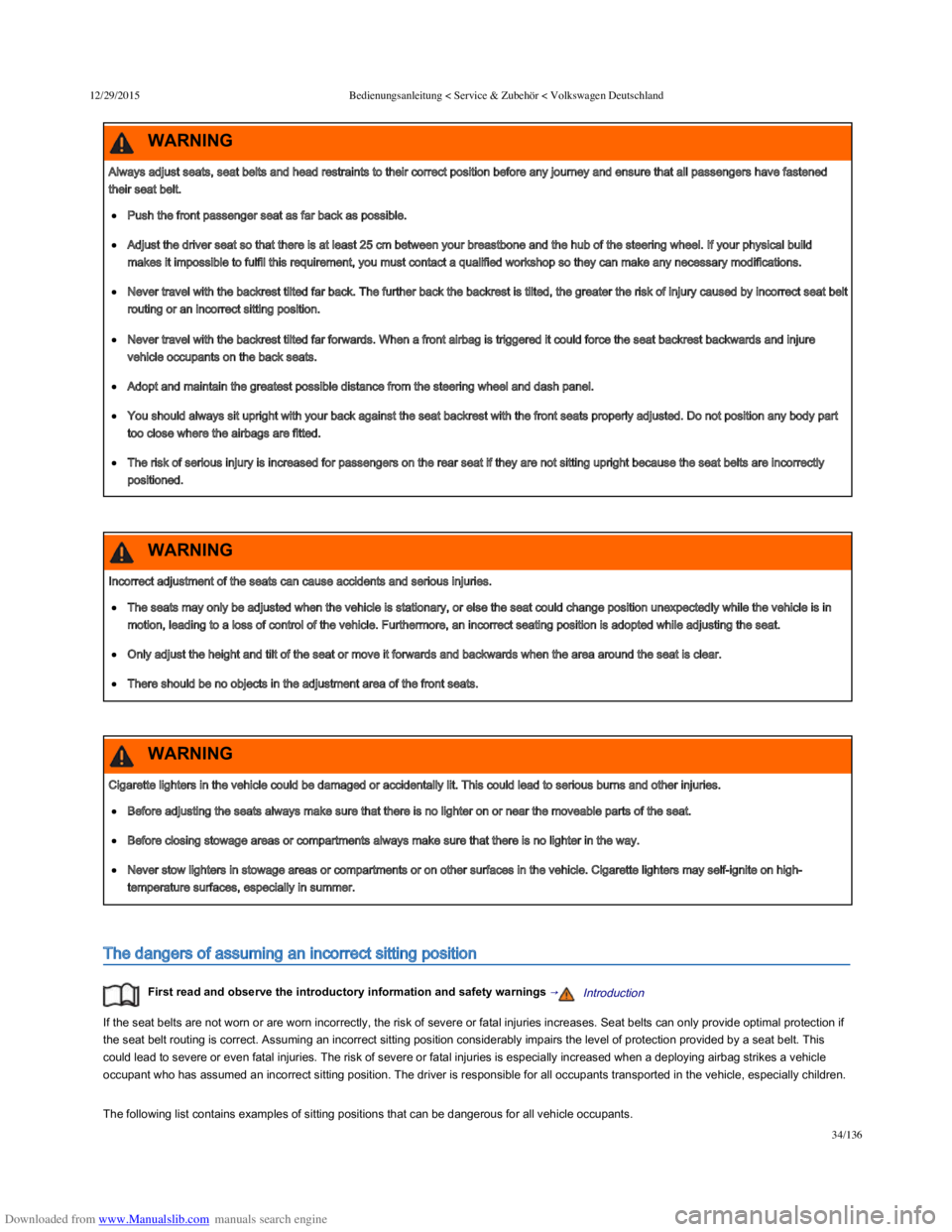
Downloaded from www.Manualslib.com manuals search engine 12/29/2015Bedienungsanleitung < Service & Zubehör < Volkswagen Deutschland
34/136
The dangers of assuming an incorrect sitting position
First read and observe the introductory information and safety warnings →Introduction
If the seat belts are not worn or are worn incorrectly, the risk of severe or fatal injuries increases. Seat belts can only provide optimal protection if
the seat belt routing is correct. Assuming an incorrect sitting position considerably impairs the level of protection provided by a seat belt. This
could lead to severe or even fatal injuries. The risk of severe or fatal injuries is especially increased when a deploying airbag strikes a vehicle
occupant who has assumed an incorrect sitting position. The driver is responsible for all occupants transported in the vehicle, especially children.
The following list contains examples of sitting positions that can be dangerous for all vehicle occupants.
Always adjust seats, seat belts and head restraints to their correct position before any journey and ensure that all passengers have fastened
their seat belt.
Push the front passenger seat as far back as possible.
Adjust the driver seat so that there is at least 25 cm between your breastbone and the hub of the steering wheel. If your physical build
makes it impossible to fulfil this requirement, you must contact a qualified workshop so they can make any necessary modifications.
Never travel with the backrest tilted far back. The further back the backrest is tilted, the greater the risk of injury caused by incorrect seat belt
routing or an incorrect sitting position.
Never travel with the backrest tilted far forwards. When a front airbag is triggered it could force the seat backrest backwards and injure
vehicle occupants on the back seats.
Adopt and maintain the greatest possible distance from the steering wheel and dash panel.
You should always sit upright with your back against the seat backrest with the front seats properly adjusted. Do not position any body part
too close where the airbags are fitted.
The risk of serious injury is increased for passengers on the rear seat if they are not sitting upright because the seat belts are incorrectly
positioned.
WARNING
Incorrect adjustment of the seats can cause accidents and serious injuries.
The seats may only be adjusted when the vehicle is stationary, or else the seat could change position unexpectedly while the vehicle is in
motion, leading to a loss of control of the vehicle. Furthermore, an incorrect seating position is adopted while adjusting the seat.
Only adjust the height and tilt of the seat or move it forwards and backwards when the area around the seat is clear.
There should be no objects in the adjustment area of the front seats.
WARNING
Cigarette lighters in the vehicle could be damaged or accidentally lit. This could lead to serious burns and other injuries.
Before adjusting the seats always make sure that there is no lighter on or near the moveable parts of the seat.
Before closing stowage areas or compartments always make sure that there is no lighter in the way.
Never stow lighters in stowage areas or compartments or on other surfaces in the vehicle. Cigarette lighters may self-ignite on high-
temperature surfaces, especially in summer.
WARNING
Page 70 of 100
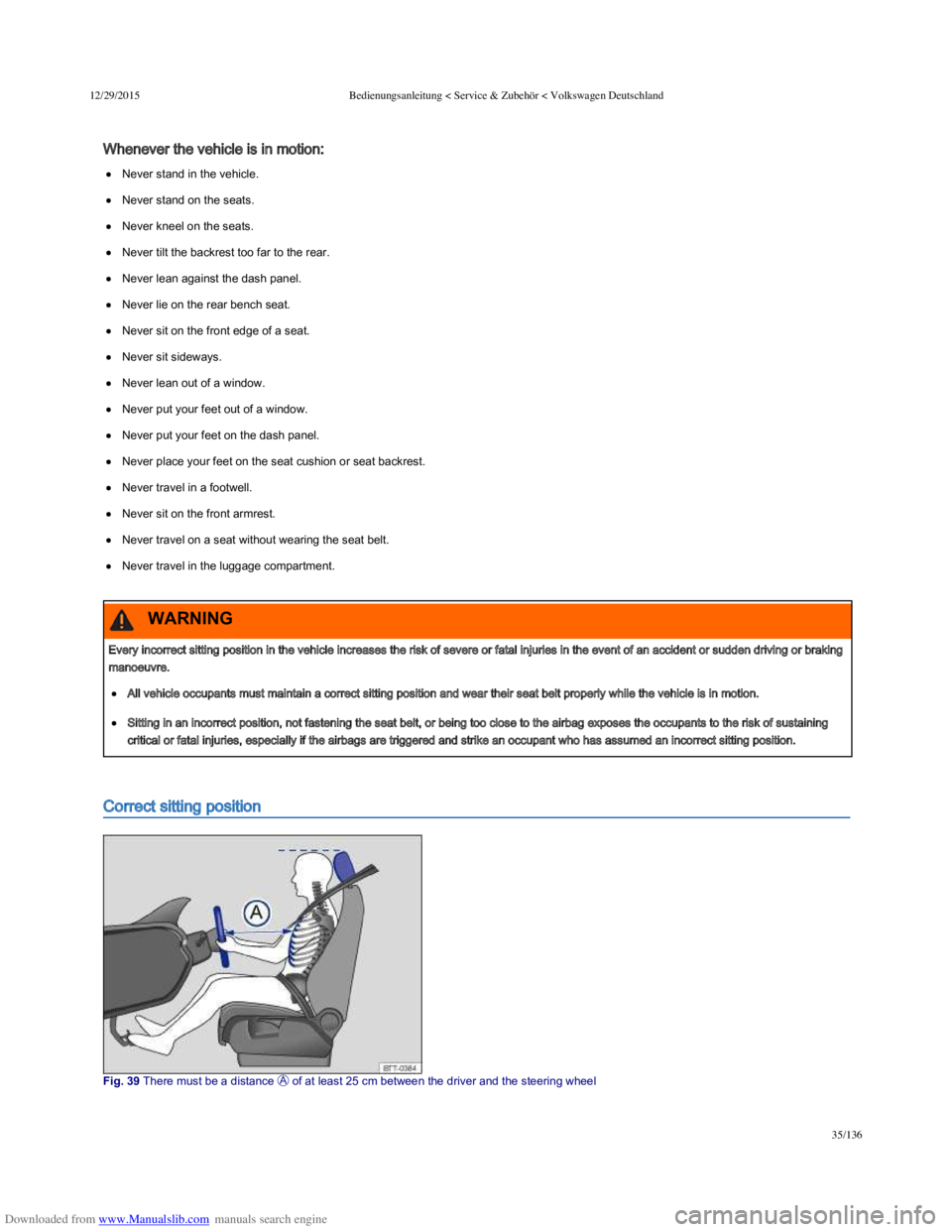
Downloaded from www.Manualslib.com manuals search engine 12/29/2015Bedienungsanleitung < Service & Zubehör < Volkswagen Deutschland
35/136
Whenever the vehicle is in motion:
Never stand in the vehicle.
Never stand on the seats.
Never kneel on the seats.
Never tilt the backrest too far to the rear.
Never lean against the dash panel.
Never lie on the rear bench seat.
Never sit on the front edge of a seat.
Never sit sideways.
Never lean out of a window.
Never put your feet out of a window.
Never put your feet on the dash panel.
Never place your feet on the seat cushion or seat backrest.
Never travel in a footwell.
Never sit on the front armrest.
Never travel on a seat without wearing the seat belt.
Never travel in the luggage compartment.
Correct sitting position
Fig. 39 There must be a distance of at least 25 cm between the driver and the steering wheel
Every incorrect sitting position in the vehicle increases the risk of severe or fatal injuries in the event of an accident or sudden driving or braking
manoeuvre.
All vehicle occupants must maintain a correct sitting position and wear their seat belt properly while the vehicle is in motion.
Sitting in an incorrect position, not fastening the seat belt, or being too close to the airbag exposes the occupants to the risk of sustaining
critical or fatal injuries, especially if the airbags are triggered and strike an occupant who has assumed an incorrect sitting position.
WARNING
Page 71 of 100
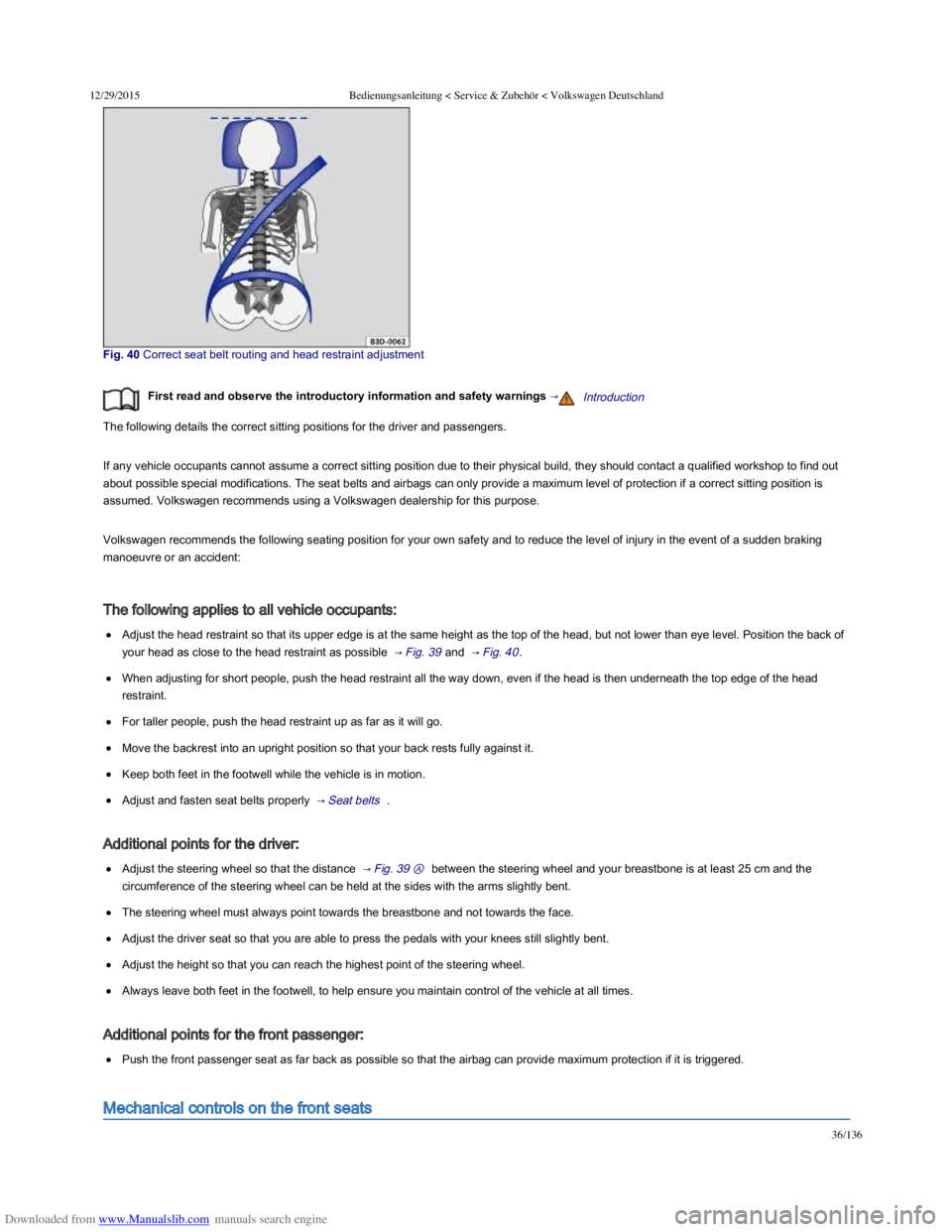
Downloaded from www.Manualslib.com manuals search engine 12/29/2015Bedienungsanleitung < Service & Zubehör < Volkswagen Deutschland
36/136
Fig. 40 Correct seat belt routing and head restraint adjustment
First read and observe the introductory information and safety warnings →Introduction
The following details the correct sitting positions for the driver and passengers.
If any vehicle occupants cannot assume a correct sitting position due to their physical build, they should contact a qualified workshop to find out
about possible special modifications. The seat belts and airbags can only provide a maximum level of protection if a correct sitting position is
assumed. Volkswagen recommends using a Volkswagen dealership for this purpose.
Volkswagen recommends the following seating position for your own safety and to reduce the level of injury in the event of a sudden braking
manoeuvre or an accident:
The following applies to all vehicle occupants:
Adjust the head restraint so that its upper edge is at the same height as the top of the head, but not lower than eye level. Position the back of
your head as close to the head restraint as possible → Fig. 39 and → Fig. 40 .
When adjusting for short people, push the head restraint all the way down, even if the head is then underneath the top edge of the head
restraint.
For taller people, push the head restraint up as far as it will go.
Move the backrest into an upright position so that your back rests fully against it.
Keep both feet in the footwell while the vehicle is in motion.
Adjust and fasten seat belts properly → Seat belts .
Additional points for the driver:
Adjust the steering wheel so that the distance → Fig. 39 Ⓐ between the steering wheel and your breastbone is at least 25 cm and the
circumference of the steering wheel can be held at the sides with the arms slightly bent.
The steering wheel must always point towards the breastbone and not towards the face.
Adjust the driver seat so that you are able to press the pedals with your knees still slightly bent.
Adjust the height so that you can reach the highest point of the steering wheel.
Always leave both feet in the footwell, to help ensure you maintain control of the vehicle at all times.
Additional points for the front passenger:
Push the front passenger seat as far back as possible so that the airbag can provide maximum protection if it is triggered.
Mechanical controls on the front seats